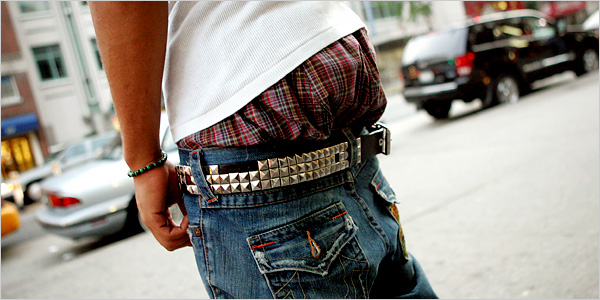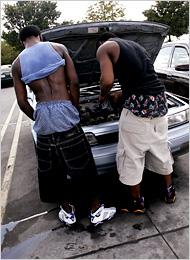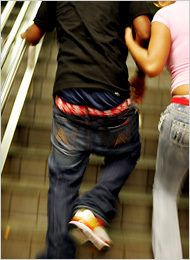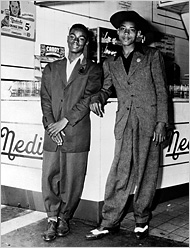| Want to send this page or a link to a friend? Click on mail at the top of this window. |
More Special Reports |
| Posted August 30, 2007 |
Are Your Jeans Sagging? Go Directly to Jail |
|
 |
|
Hiroko Masuike for The New York Times |
|
| BOXER REBELLION The saggy style is in full view in the East Village. |
By NIKO KOPPEL |
JAMARCUS MARSHALL, a 17-year-old high school sophomore in Mansfield, La., believes that no one should be able to tell him how low to wear his jeans. “It’s up to the person who’s wearing the pants,” he said.
Mr. Marshall’s sagging pants, a style popularized in the early 1990s by hip-hop artists, are becoming a criminal offense in a growing number of communities, including his own.
Starting in Louisiana, an intensifying push by lawmakers has determined pants worn low enough to expose underwear poses a threat to the public, and they have enacted indecency ordinances to stop it.
Since June 11, sagging pants have been against the law in Delcambre, La., a town of 2,231 that is 80 miles southwest of Baton Rouge. The style carries a fine of as much as $500 or up to a six-month sentence. “We used to wear long hair, but I don’t think our trends were ever as bad as sagging,” said Mayor Carol Broussard.
 |
 |
 |
||||
Mei-Chun Jan/Dallas Morning News - Associated Press |
Hiroko Masuike for The New York Times |
Bettman/Corbis |
||||
| TESTING BOUNDARIES Examples of saggy pants in different parts of the nation. | Some communities have outlawed this style. | The reaction reminds some of the outrage engendered by zoot suit styles during the 1940's. |
An ordinance in Mansfield, a town of 5,496 near Shreveport, subjects offenders to a fine (as much as $150 plus court costs) or jail time (up to 15 days). Police Chief Don English said the law, which takes effect Sept. 15, will set a good civic image.
Behind the indecency laws may be the real issue — the hip-hop style itself, which critics say is worn as a badge of delinquency, with its distinctive walk conveying thuggish swagger and a disrespect for authority. Also at work is the larger issue of freedom of expression and the questions raised when fashion moves from being merely objectionable to illegal.
Sagging began in prison, where oversized uniforms were issued without belts to prevent suicide and their use as weapons. The style spread through rappers and music videos, from the ghetto to the suburbs and around the world.
Efforts to outlaw sagging in Virginia and statewide in Louisiana in 2004, failed, usually when opponents invoked a right to self-expression. But the latest legislative efforts have taken a different tack, drawing on indecency laws, and their success is inspiring lawmakers in other states.
In the West Ward of Trenton, Councilwoman Annette Lartigue is drafting an ordinance to fine or enforce community service in response to what she sees as the problem of exposing private parts in public.
“It’s a fad like hot pants; however, I think it crosses the line when a person shows their backside,” Ms. Lartigue said. “You can’t legislate how people dress, but you can legislate when people begin to become indecent by exposing their body parts.”
The American Civil Liberties Union has been steadfast in its opposition to dress restrictions. Debbie Seagraves, the executive director of the A.C.L.U. of Georgia said, “I don’t see any way that something constitutional could be crafted when the intention is to single out and label one style of dress that originated with the black youth culture, as an unacceptable form of expression.”
School districts have become more aggressive in enforcing dress bans, as the courts have given them greater latitude. Restrictions have been devised for jeans, miniskirts, long hair, piercing, logos with drug references and gang-affiliated clothing including colors, hats and jewelry.
Dress codes are showing up in unexpected places. The National Basketball Association now stipulates that no sports apparel, sunglasses, headgear, exposed chains or medallions may be worn at league-sponsored events. After experiencing a brawl that spilled into the stands and generated publicity headaches, the league sought to enforce a business-casual dress code, saying that hip-hop clothing projected an image that alienated middle-class audiences.
According to Andrew Bolton, the curator at the Costume Institute of the Metropolitan Museum of Art, fashions tend to be decried when they “challenge the conservative morality of a society.”
Not since the zoot suit has a style been greeted with such strong disapproval. The exaggerated boxy long coat and tight-cuffed pants, started in the 1930s, was the emblematic style of a subculture of young urban minorities. It was viewed as unpatriotic and flouted a fabric conservation order during World War II. The clothing was at the center of what were called Zoot Suit Riots in Los Angeles, racially motivated beatings of Hispanic youths by sailors. The youths were stripped of their garments, which were burned in the street.
Following a pattern of past fashion bans, the sagging prohibitions are seen by some as racially motivated because the wearers are young, predominantly African-American men.
Yet, this legislation has been proposed largely by African-American officials. It may speak to a generation gap. Michael Eric Dyson, a professor of sociology at Georgetown University and the author of “Know What I Mean?: Reflections on Hip Hop,” said, “They’ve bought the myth that sagging pants represents an offensive lifestyle which leads to destructive behavior.”
Last week, Atlanta Councilman C. T. Martin sponsored an amendment to the city’s indecency laws to ban sagging, which he called an epidemic. “We are trying to craft a remedy,” said Mr. Martin, who sees the problem as “a prison mentality.”
But Larry Harris, Jr., 28, a musician from Miami, who stood in oversize gear outside a hip-hop show in Times Square, denied that prison style was his inspiration. “I think what you have here is people who don’t understand the language of hip-hop,” he said.
A dress code ordinance proposed in Stratford, Conn., by Councilman Alvin O’Neal was rejected at a Town Council meeting last Monday, drawing criticism that the law was unconstitutional and unjustly encouraged racial profiling. Many residents agreed that the town had more pressing issues.
Benjamin Chavis, the former executive director of the N.A.A.C.P., said, “I think to criminalize how a person wears their clothing is more offensive than what the remedy is trying to do.”
Dr. Chavis, who is often pictured in an impeccable suit and tie among the baggy outfits of the hip-hop elite, is a chairman of the Hip Hop Summit Action Network, a coalition he founded with the music mogul Russell Simmons. He said that the coalition will challenge the ordinances in court.
“The focus should be on cleaning up the social conditions that the sagging pants comes out of,” he said. “That they wear their pants the way they do is a statement of the reality that they’re struggling with on a day-to-day basis.”
Copyright 2007 The New York Times Company. Reprinted from The New York Times, National, of Thursday, August 30, 2007.
| Wehaitians.com, the scholarly journal of democracy and human rights |
| More from wehaitians.com |